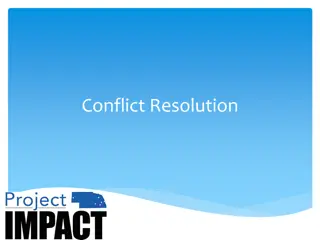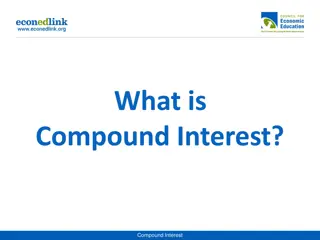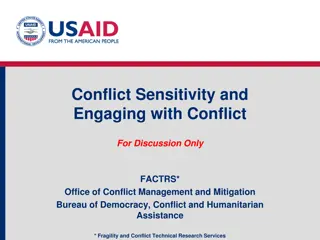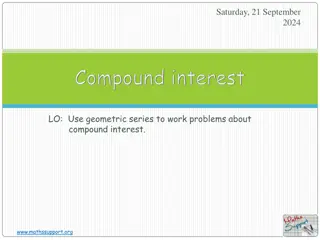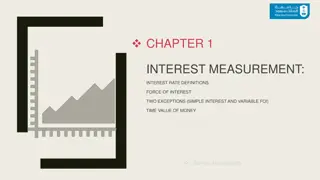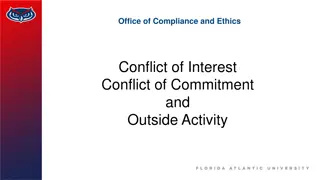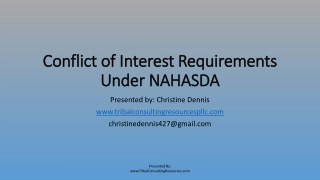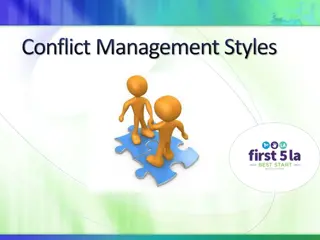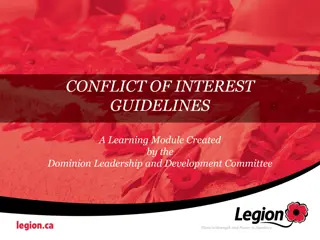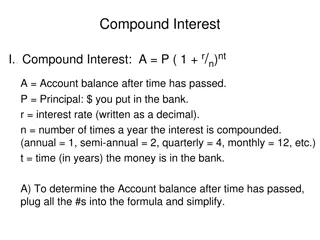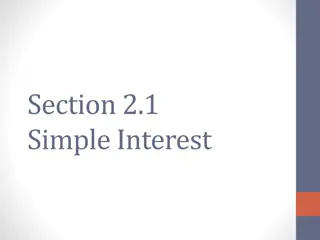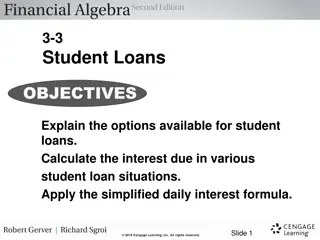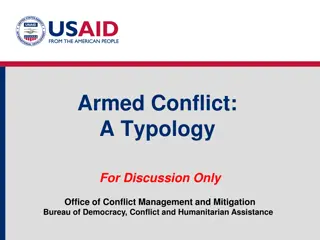Conflict of Interest in NITAGs: Prevention and Management
Understanding and preventing conflicts of interest in National Immunization Technical Advisory Groups (NITAGs) is essential for maintaining integrity in decision-making processes. This training program covers identifying conflicts, developing prevention policies, and analyzing scenarios to enhance ethical practices.
Download Presentation

Please find below an Image/Link to download the presentation.
The content on the website is provided AS IS for your information and personal use only. It may not be sold, licensed, or shared on other websites without obtaining consent from the author. Download presentation by click this link. If you encounter any issues during the download, it is possible that the publisher has removed the file from their server.
E N D
Presentation Transcript
Prevention and Management of Conflict of Interest in National Immunization Technical Advisory Groups (NITAGs) This version has been reviewed by Pooja Pradeep, instructional designer & endorsed by the GNN in September 2020. Immunization, Vaccines and Biologicals
Before we start: Note the alphabet code assigned on the pre-training form. Ensure you take a form with the same alphabet code for the later post-training from. All forms are anonymous. The letter code is only to ensure uniformity. The forms are a short quiz and will not be graded. The evaluations will be used only to help us enhance our training packages. All the best! NITAG Conflict of Interest Prevention and Management 1
Learning Objectives On completion of this training, you will be able to: Describe what constitutes a Conflict of Interest at the NITAG level Identify the difference between an Interest vs Conflict of Interest in the context of a NITAG Outline different ways to prevent Conflict of Interests at the NITAG level Summarize the key points involved in developing a Conflict of Interest Prevention and Management Policy for NITAG Analyze different NITAG scenarios to identify potential Conflict of Interests and develop best practices NITAG Conflict of Interest Prevention and Management 2
Interests We all have interests personal, family, work etc. Can you list a few interests that play an important role in your life? http://hikorimg.pw/Geometrik-ekiller-Etkinlikler-ve-oyunlar-t-Shapes.html NITAG Conflict of Interest Prevention and Management 3
Competing Interests Do all interests automatically turn into a Conflict of Interest? No. All Interests do not automatically turn into a Conflict of Interest. Some times our interests are in conflict; often not. Conflict of Interests are situations that are highly context-specific. Assessing if an interest is in conflict cannot be made by oneself. NITAG Conflict of Interest Prevention and Management 4
What is a Conflict of Interest (CoI) for NITAGs? A CoI is a situation where multiple and competing interests of a person play out at the same time, having the potential of compromising their objective decision- making process. In the context of NITAG, any member whose interest may affect, or may reasonably be perceived to affect, the member's objectivity and independence represents a potential Conflict of Interest. NITAG Conflict of Interest Prevention and Management 5
INTERESTS THAT MAY EXERT AN INFLUENCE NITAG Conflict of Interest Prevention and Management 6
Types of interest: financial vs non-financial A financial interest involves material advantage such as a financial benefit, with or without direct money transfer (but with a given value) Consultancy, employment, gifts, support to attend a conference Grant, fellowship for a post in the department Shareholdings, Intellectual Property rights (e.g. patent) A non-financialinterest involves a non-material advantage Personal beliefs (e.g. religious, political) or affiliation to an organization with some official position >> intellectual bias Personal network Career advancement and honors NITAG Conflict of Interest Prevention and Management 7
Types of interest: personal vs non personal A personal interest involves an advantage benefiting the member personally Directly Through one or more close family members (indirectly) A non-personal interest involves an advantage benefiting the department/organization in which the member works NITAG Conflict of Interest Prevention and Management 8
Other features of an interest to be considered: Significance e.g. financially significant or insignificant (varies with context) Specific vs non specific interest Depending whether it is directly related to a topic under discussion or not Advantage, non-disadvantage, disadvantage An advantage / benefit for the member (or a third party an individual or an organization the member is linked to) A prevention of a disadvantage (for the member or a third party) A disadvantage for a third party, in a context of competition Consideration relative to time Former interests, which no longer exist (since when?) Current (ongoing) interests Future (potential) interests NITAG Conflict of Interest Prevention and Management 9
Interests can exist in relation with? Private/Public vaccine manufacturers Private donors, including not-for-profit organizations Technical agencies and public health institutes Public donor agencies and international financial institutions Governments Academia and research institutes, especially for non-financial interests related to the career and reputation of the member Professional associations Family and friends Vested personal interest in a topic of debate NITAG Conflict of Interest Prevention and Management 10
Interest vs Conflict of Interest? Example of an interest leading to a CoI: If a member works as a consultant on the rotavirus vaccine for vaccine manufacturer X and if they had to discuss and vote about the introduction of a rotavirus vaccine in the NIP: It would be a CoI as they may be influenced by the work performed or by the marketing message delivered by the manufacturer. They may also have personal interests related to the marketing of this vaccine (e.g. being offered a position or invitations to international conferences). Such a consultancy may alter their impartiality. NITAG Conflict of Interest Prevention and Management 11
Interest vs Conflict of Interest? Example of an interest not leading to a CoI: However, for another topic on the NITAG agenda which is not related to rotavirus vaccine nor the vaccine manufacturer X, it is unlikely that this interest would influence the member during the discussion. NITAG Conflict of Interest Prevention and Management 12
MANAGEMENT AND PREVENTION OF CONFLICTS OF INTEREST NITAG Conflict of Interest Prevention and Management 13
Guidelines to help NITAGs in developing, implementing and improving their own policy Available in English only Can be downloaded from the NITAG Resource Page NITAG Conflict of Interest Prevention and Management 14
Different ways to prevent conflict of interests and keep the trust! Take a few minutes and reflect on what might be a few strategies that can help prevent Conflict of Interests and enhance trust in your NITAG. Get innovative with your ideas and share your reflections. Formulate a checklist based on all the suggestions. NITAG Conflict of Interest Prevention and Management 15
Different ways to prevent conflict of interests and keep the trust! Use of a systematic process for issuing evidence-based recommendations including evidence to decision framework. Disclosure of a short CV and affiliation. Diversity of the group. Policy to prevent and manage conflicts of interest. Declaration of interests with careful review. Foster a culture of transparency, objectivity and trust CoI situation must be seen purely from an objective lens, giving no scope for any sort of fear, allegation or stigma to prevail. Encourage members to regularly and proactively declare their interests. NITAG Conflict of Interest Prevention and Management 16
Purpose of a NITAG policy to prevent and manage CoI Prevent situations in which NITAG members or its secretariat or those who review evidence perform their work on/for the NITAG while having conflicting interests. Actual influence of any interest Perception of a possible CoI Contribute to maintain/enhance transparency of the recommendation-making process. Robustness and transparency of the systematic recommendation-making process is a complementary means to ensure independence of the NITAG. Maintain the trust and credibility. So critical that it is one of the six basic indicators set out by WHO to assess functionality of a NITAG. NITAG Conflict of Interest Prevention and Management 17
A CoI prevention and management policy aims to protect? The NITAG member, who could otherwise be suspected, rightly or wrongly, of having been influenced by outside interests during the recommendation-making process. The NITAG, which could otherwise appear as not legitimate, independent and science-based. The MoH and National Immunization Programme whose decisions could otherwise lack credibility (could fuel vaccine hesitancy). NITAG Conflict of Interest Prevention and Management 18
Policy process Step one Declare interests WHO? NITAG Secretariat, core members including NITAG Chair and working group members i.e. those involved in the decision making and review of evidence. WHEN? 1. When being appointed 2. Annually or before each meeting 3. Proactively, if there is a meaningful change NITAG Conflict of Interest Prevention and Management 19
Policy process Step two Record & Disclose WHO? The NITAG Secretariat. How? Recorded in a consistent format and made available for audit. The more transparent the better: ideally, declarations of interests are publicly disclosed (summarized) in the meeting minutes / on the website of the NITAG. Disclosure does not eliminate the CoI but mitigates its impact. NITAG Conflict of Interest Prevention and Management 20
Policy process Step three Assess WHO? The NITAG Secretariat and Chair with support of legal department if necessary. When? Before each NITAG meeting, considering each topic to be discussed. How? By considering the following elements: Amount of benefit and its significance Personal versus non personal nature Directness with regard to topic under discussion Frequency/nature of the relationship with the source of interest When the interest started/took place or will start or end Assessment remains in part subjective and can be conducted on a case-by-case basis with specific criteria NITAG Conflict of Interest Prevention and Management 21
Policy process Step four Inform & implement WHO? The NITAG Secretariat and Chair inform the NITAG member. What are the potential outcomes? Participation in the discussion AND in the decision-making Participation in the discussion (possibly only answering questions) BUT NOT in the voting Exclusion from both the discussion AND the voting. Decisions should be documented and recorded. NITAG Conflict of Interest Prevention and Management 22
The WHO balancing test The answer is not always black & white: Nature, type and magnitude of the interest and therefore the degree to which the interest may be reasonably expected to influence the expert's judgment Versus Adequacy of the measures/options available to protect the independence and integrity of the decision-making process NITAG Conflict of Interest Prevention and Management 23
Developing a CoI prevention and management policy The policy of each NITAG should take the national setting into account Existing legislation regarding CoI-management Standards of practice and cultural aspects regarding disclosure of interests Step by step process: Clarification of the scope of CoIs to be prevented Definition of the CoI-prevention process Development of the tools to implement CoI-prevention policy Involvement of NITAG members during the process to develop the policy NITAG Conflict of Interest Prevention and Management 24
Points to consider for developing a CoI prevention and management policy If you are to help set up a CoI prevention and management policy for your NITAG what would be a few key principles to take into consideration? Can you list a few points? NITAG Conflict of Interest Prevention and Management 25
Points to consider for developing a CoI prevention and management policy Key principles To be adjusted at country level Process should be well described (SOP) Declaration process Build trust Frequency of declaration/update Take national setting into account Level of details Existing legislation regarding CoI-management Assessment process and rules Standards of practice and cultural aspects Categorization of interests? Step by step process including development of necessary tools Criteria to assess? Stringency of the rules thresholds? Involvement of NITAG members Disclosure policy Interests should be regularly declared Extent to which the declarations of interests are made public Interests should be assessed, recorded and disclosed as appropriate. Outcomes of assessment should be clear and documented Outcomes of decisions
Examples of country-level NITAG CoI policy France USA (Pg.14) Australia
Major pitfalls/challenges What are some of the challenges you have experienced/foresee in the successful implementation of a CoI prevention and management policy at your NITAG? NITAG Conflict of Interest Prevention and Management 28
Major pitfalls/challenges Policy only on paper versus implemented Nothing done with DoIs Often seen as a pain - Need to educate and inform members Lack of updating of DoI Insufficient reporting (pre-determination by expert of what to report). Better to report more! Not enough specificity/details in the completed DoIs NITAG Conflict of Interest Prevention and Management 29
Is this worrisome? NITAG Conflict of Interest Prevention and Management 30
Is this less worrisome? NITAG Conflict of Interest Prevention and Management 31
Activity Time! Analyse Identify Develop! NITAG Conflict of Interest Prevention and Management 32
A few questions to assess John Smith works only part-time (50%) for a private vaccine manufacturing company. Can he be a NITAG member? Louise Dupont is a NITAG member. Her spouse regularly conducts consultancies for one of the companies manufacturing PCV. Revision of PCV schedule is on the next NITAG meeting agenda. What should she do? Kalyar Win has received two grants - one to examine PCV side effects in the elderly funded by a company and one to look at factors that influence acceptance of HPV vaccine by school girls from the National Research Council. What should she do? Samuel Daye is a member of the secretariat and ex officio to the NITAG. His son has just started as the marketing director for a local vaccine manufacturing company that makes a pentavalent vaccine for infants. What should he do? NITAG Conflict of Interest Prevention and Management 33
Lets look at each of the cases John Smith works only part-time (50%) for a private vaccine manufacturing company. Is there a conflict of interest? Should he be a NITAG member? NITAG Conflict of Interest Prevention and Management 34
John Smith Is there a conflict of interest? Yes; Financial, Personal, Direct, Current Should he serve as NITAG member? No, even if company is not producing vaccines specific to the discussion. Why? Because: 1. There would be a perception that he cannot give an independent opinion because of his personal direct interest 2. The NITAG will be perceived as being under the influence of a pharma company Consider adding to the ToRs a policy that No member, his or her spouse, or a member of his or her immediate family can be directly employed by a vaccine manufacturer or its parent company" NITAG Conflict of Interest Prevention and Management 35
Lets look at each of the cases Louise Dupont is a NITAG member. Her spouse regularly conducts consultancies for one of the companies manufacturing PCV. Revision of PCV schedule is on the next NITAG meeting agenda. What should she do? Is there a conflict of interest? If so, how should it be managed? NITAG Conflict of Interest Prevention and Management 36
Louise Dupont What should she do? She should flag this interest to the NITAG Secretariat and Chair Is there a conflict of interest? Yes; Financial, Personal, Indirect, Specific, Significant, Current How could the Secretariat manage the COI? Exclude the member from PCV discussions and vote (or only from vote) NITAG Conflict of Interest Prevention and Management 37
Lets look at each of the cases Kalyar Win has received two grants, 1) to examine PCV side effects in the elderly, funded by a company and 2) to look at factors that influence acceptance of HPV vaccine by school girls, funded by the National Research Council. What should she do? Is there a conflict of interest? If so, how could the Secretariat manage the COI? NITAG Conflict of Interest Prevention and Management 38
Kaylar Win What should she do? She should flag this interest to the NITAG Secretariat and Chair Is there a conflict of interest? Re: PCV - More information is needed to determine the type of interest and the relationship of the member to the company beyond the grant Re: HPV - More information is needed to determine the type of interest, but it poses less of a problem since it is publicly funded How could the Secretariat manage the COI? Re: PCV - Exclude the member from PCV discussions and vote (or only from vote) Re: HPV - Exclude the member from HPV vote NITAG Conflict of Interest Prevention and Management 39
Lets look at each of the cases Samuel Daye is a member of the secretariat and ex officio to the NITAG. His son has just started as the marketing director for a local vaccine manufacturing company that makes a pentavalent vaccine for infants . What should he do? Is there a conflict of interest? If so, how could the Secretariat manage the COI? NITAG Conflict of Interest Prevention and Management 40
Samuel Daye What should he do? He should flag this interest to the NITAG Secretariat and Chair Is there a conflict of interest? Financial, personal, indirect, specific to vaccines, significant, current How could the Secretariat manage the COI? Exclude from discussion related to the change in pentavalent use of schedule. NITAG Conflict of Interest Prevention and Management 41
Take away messages Perception of a possible CoI can be harmful for the NITAG reputation and credibility. A CoI prevention and management policy is critical but not the only tool to avoid CoIs. The more stringent the better local context to be considered and appropriate balance to be found. A CoI management policy is also about transparency to maintain/increase trust. Issue of CoI can be sensitive, and sometimes misunderstood. Developing a policy requires involving the NITAG members. Conflict of interests are not only about dealing with industry. Use the guidelines and please share experience with peers within the network. NITAG Conflict of Interest Prevention and Management 42
Before we end: Please take a post-training form with the same alphabet code as your earlier pre- training form. All forms are anonymous. The letter code is only to ensure uniformity. The forms are a short quiz and will not be graded. The evaluations will be used only to help us enhance our training packages. All the best! NITAG Conflict of Interest Prevention and Management 43
Thank you for your attention! These slides were developed with inputs from the GNN, the WHO regional offices and our partner the US-CDC. Thanks to all of them.



